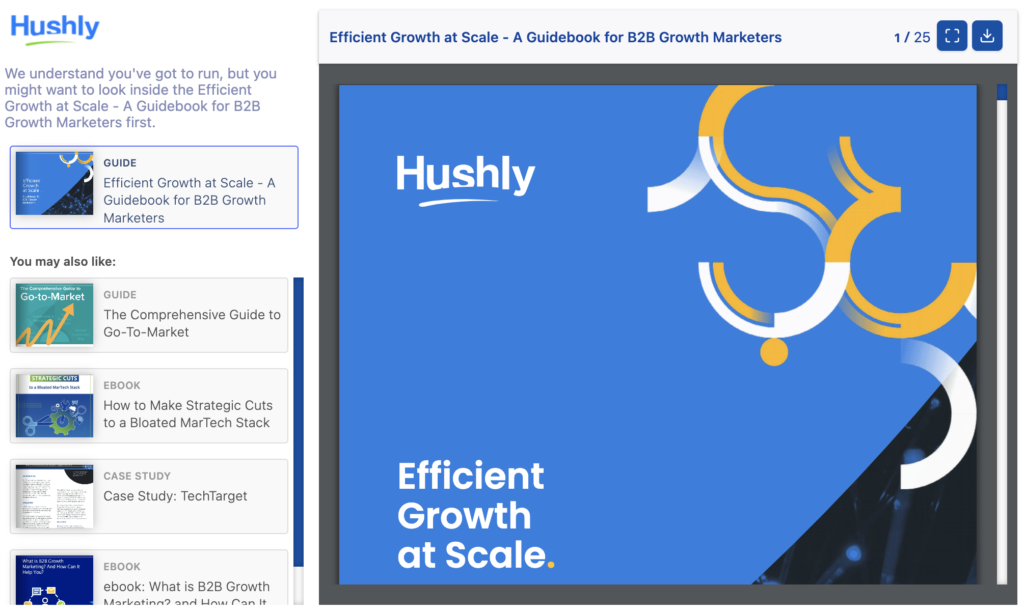Filters
Content Type
Topic
Stop Losing Leads: How to Retarget Website Visitors
Generating leads is like collecting seashells at the beach. When the water recedes, you can see dozens of shimmering shells. But before you can collect them, the next wave comes in, returning them to the sea. You’re left with a few stragglers caught in the sand.
Not all visitors to your website stay. And when they leave, they’re often lost for good unless you can retarget those visitors.
Retargeting visitors helps you capture and keep those valuable leads your website brings in. Learn how to retarget website visitors using Hushly’s leading AI-powered tools.

Why Do You Need to Use Website Retargeting?
B2B retargeting reduces your cost per lead while maximizing your return on investment.
If you spend $10,000 to generate 300 leads, your cost per lead is just over $33. However, there are a significant number of website visitors and leads who responded to those $10k worth of marketing strategies but never converted.
Instead of spending $10,000 more to generate another 300 leads, you can retarget leads you already reached, helping your marketing investment go further.
The Goal of B2B Retargeting on Your Website
Businesses often confuse retargeting with remarketing.
Remarketing strategies reengage current customers who lost interest. They might be leads clicking on marketing emails and showing potential who stopped engaging with your nurturing campaigns.
Remarketing may also reach customers who purchased in the past but haven’t repurchased, had a subscription but canceled, or stopped in the middle of the purchase process.
Retargeting, on the other hand, reengages leads who haven’t become customers yet. They could be anonymous website visitors who read a few blog posts before leaving. They may still be valuable customers, but they didn’t see relevant content during their brief visit.
You may also have visitors who filled out the lead generation form but lost interest and didn’t engage with any emails or promos.
Retargeting goals include:
- Recapturing attention with fresh, personalized content
- Showing relevant alternatives and new products they might not have seen on the first visit
- Educating the lead on your company to build more trust
Why You Need More than Native Display Ads
One of the most well-known examples of retargeting is native display ads. Native display ads use cookies to track website visitors. Then, a native ad stream on third-party websites displays your products or business information to try and bring those visitors back to your site.
Google is cracking down on browsing security, with plans to disable cookie tracking starting in 2024.
A cookieless future means fewer tracking options beyond your website.
If you’re wondering, can I retarget website visitors without cookies? The answer is yes.
While you don’t need to delete all your native display ads yet (and shouldn’t), you should look to alternative methods for tracking and retargeting anonymous and captured leads. The alternative methods will target leads who have cookies disabled and will outlast Google privacy changes.
How to Retarget Website Visitors Using Hushly’s AI-Powered Tools
Learn how to retarget your website visitors using five alternatives to native display using Hushly’s AI-powered tools.
1. Personalize the Browsing Experience
Why do people leave websites? The answer is often simple: visitors can’t find the information they need, and the content isn’t irrelevant.
However, just because visitors don’t see relevant information doesn’t mean the website is irrelevant. Often, visitors simply didn’t know where to look.
A personalized browsing experience updates content feed in real-time, ensuring visitors see relevant content customized to the viewer. For instance, Hushly’s platform uses traffic sources, user behavior, and forms to understand potential pain points. Then, the platform suggests content relevant to the audience with specific solutions that apply to the audience’s needs.
We also offer ChatGPT-powered interactive content. If audiences don’t see relevant content, they can ask their questions instead of leaving.
2. Use Exit Intent Pop-Ups
Exit pop-ups target visitors who may be about to leave. Certain events can trigger a pop-up, including:
- Scrolling behavior: When visitors scroll a certain length down the page or start scrolling up
- Time: When visitors are on a page past the average browsing time
- Actions: When visitors switch between tabs, go back, or try to close the window
- Inactivity: When visitors don’t perform any actions in a while
You select the actions you want to trigger a pop-up, then choose the most effective content to reengage those visitors.
For instance, Hushly’s website suggests further reading based on what pages a visitor previewed to try and reengage website visitors. Other businesses may offer a discount or unique offer to pique the visitor’s interest.

Image from Hushly
3. Simplify Lead Capture
Leads are much easier to retarget if you have their information. While you don’t want to lose website visitors before they convert, your secondary goal should be to ensure no visitor remains anonymous if they do leave.
Lead capture forms will vastly improve the effectiveness of your retargeting attempts, as you’ll have a name and email to go along with the user data and behavior.
Keeping your lead capture forms simple will increase the number of leads you can generate. Typeform’s analysis of 10,000 forms saw that forms with three fields had 28% higher completion rates than those with ten questions.
If a customer is a serious buyer, they may not mind filling in 5+ form fields because they’re engaged and ready to buy. However, if someone is on the fence and considering leaving your website, they wouldn’t want to put forth that type of effort. Instead, offer a smaller two-field form that promises more relevant content. They are more likely to complete the form and explore the content.
Additionally, multi-asset forms encourage leads to view multiple assets without reentering information, which will have a greater chance of engaging an unengaged visitor.
4. Begin an Email Campaign
Retargeting isn’t just about reengaging anonymous visitors. You may also need to retarget leads who filled out a contact form and then went silent.
Retargeting leads you are already connected with is easier than anonymous leads because you can gain significant information from their contact form. For instance, their email tells you whether they’re a business or an individual. If they are a business, the email domain tells you which business.
You can also use their behavior on your website to understand what they might have been looking for and how close they may be to purchasing.
Hushly streamlines that process with our AI-powered lead scoring and segmentation tools. You can input those leads into the most relevant retargeting email campaigns. The campaign then uses AI to adjust according to recipient behavior. For instance, you can decide how long to wait between emails before sending the next one and what email to send if the recipient does open and engage with the correspondence.
B2B email campaigns are a powerful way to retarget potential leads, as the average ROI of email marketing is $40 for every $1 of marketing spend.
5. Offer an Incentive
Just because visitors leave your website doesn’t mean they aren’t interested. It also doesn’t necessarily mean they didn’t find what they were looking for.
Some visitors do find a solution to their challenge on your site and want to purchase. However, they did not immediately go through with the purchase or a demo signup because of the cost, timing, or simply because they were distracted.
Incentive retargeting effectively reaches those visitors by offering discounts, promos, or special gifts. Offering an incentive, especially a time-sensitive one, may ease price concerns and push for immediate action.
You can add an incentive to your exit pop-up or retargeting emails. You might also consider adding incentives to your lead capture forms so you can remove barriers before they’re even considering leaving.
Lead capture incentives can significantly increase the number of visitors who fill out the lead capture form, removing anonymity from your retargeting campaigns.
Expand Your Retargeting Efforts and Capture More B2B Leads
What is the best way to retarget website visitors?
The best way is using first-party data and personalized experiences to connect with website visitors so they don’t leave. But, Hushly also offers a safety net to retarget visitors who may still consider leaving without converting.
By expanding your retargeting efforts, you can decrease your cost per lead and increase the number of website visitors who turn into customers.
Recapture more leads using Hushly’s AI-powered retargeting tools, even as privacy laws and cookie blocking continue to rise.
Schedule a demo and stop losing your valuable leads.
The post Stop Losing Leads: How to Retarget Website Visitors appeared first on Hushly.



